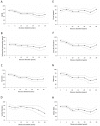Modeling of cognitive impairment by disease duration in multiple sclerosis: a cross-sectional study
- PMID: 23936485
- PMCID: PMC3731335
- DOI: 10.1371/journal.pone.0071058
Modeling of cognitive impairment by disease duration in multiple sclerosis: a cross-sectional study
Abstract
Background/aims: Large-scale population studies measuring rates and dynamics of cognitive decline in multiple sclerosis (MS) are lacking. In the current cross-sectional study we evaluated the patterns of cognitive impairment in MS patients with disease duration of up to 30 years.
Methods: 1,500 patients with MS were assessed by a computerized cognitive battery measuring verbal and non-verbal memory, executive function, visual spatial perception, verbal function, attention, information processing speed and motor skills. Cognitive impairment was defined as below one standard deviation (SD) and severe cognitive impairment as below 2SD for age and education matched healthy population norms.
Results: Cognitive performance in our cohort was poorer than healthy population norms. The most frequently impaired domains were information processing speed and executive function. MS patients with secondary-progressive disease course performed poorly compared with clinically isolated syndrome, relapsing-remitting and primary progressive MS patients. By the fifth year from disease onset, 20.9% of patients performed below the 1SD cutoff for impairment, p=0.005, and 6.0% performed below the 2SD cutoff for severe cognitive impairment, p=0.002. By 10 years from onset 29.3% and 9.0% of patients performed below the 1SD and 2SD cutoffs, respectively, p=0.0001. Regression modeling suggested that cognitive impairment may precede MS onset by 1.2 years.
Conclusions: The rates of cognitive impairment in this large sample of MS patients were lower than previously reported and severe cognitive impairment was evident only in a relatively small group of patients. Cognitive impairment differed significantly from expected normal distribution only at five years from onset, suggesting the existence of a therapeutic window during which patients may benefit from interventions to maintain cognitive health.
Conflict of interest statement
Figures




References
-
- Achiron A, Barak Y (2006) Cognitive changes in early MS: a call for a common framework. J Neurol Sci 245: 47–51. - PubMed
-
- Staples D, Lincoln NB (1979) Intellectual impairment in multiple sclerosis and its relation to functional abilities. Rheumatol Rehabil 18: 153–160. - PubMed
-
- Medaer R, De Smedt L, Swerts M, Geutjens J (1984) Use of rating scales to reflect cognitive and mental functioning in multiple sclerosis. Acta Neurol Scand Suppl 101: 65–67. - PubMed
-
- Patti F, Amato MP, Trojano M, Bastianello S, Tola MR, et al. (2009) COGIMUS Study Group. Cognitive impairment and its relation with disease measures in mildly disabled patients with relapsing-remitting multiple sclerosis: baseline results from the Cognitive Impairment in Multiple Sclerosis (COGIMUS) study. Mult Scler 15: 779–788. - PubMed
-
- McIntosh-Michaelis SA, Roberts MH, Wilkinson SM, Diamond ID, McLellan DL, et al. (1991) The prevalence of cognitive impairment in a community survey of multiple sclerosis. Br J Clin Psychol 30: 333–348. - PubMed
Publication types
MeSH terms
LinkOut - more resources
Full Text Sources
Other Literature Sources
Medical

